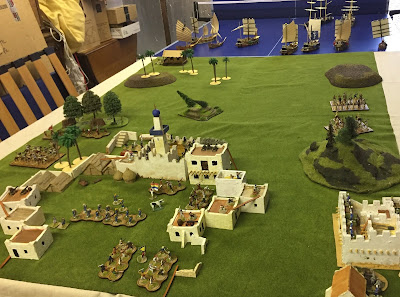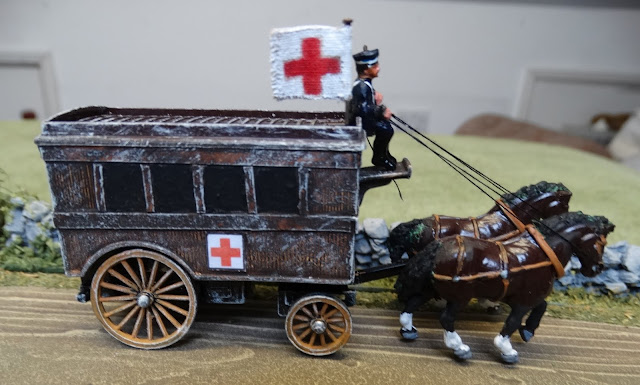When I first got my diagnosis of
cancer and was given ‘months’ I thought it was time to have a sort out of the
figures and down size. Jack had made me
a number of ships over the years which were really great but difficult to sell
on line because of their fragility and subsequent packaging.
I contacted gamers who I had been in
touch with over time to see if they were interested in the models and more
importantly could they physically collect them from my home. Payment was a voluntary contribution to Cancer
Research UK of what they thought the models and figures were worth.
One gamer Richard Wells came up from
Kent to collect some ships and other bits and I have stayed in touch with him
and his progress towards getting his table sorted out. I am delighted to say that the models have
finally hit the table and Richard has kindly sent me some pictures and a
description of his game which he has agreed that I can post on my blog.
So I give you the Battle of
Chongzhou:
A British force under the command of General
Wells were instructed to relief a German and French force, running out of
supplies and tied up in a fort next to the River Sonlung very close to the
Chinese held town of Chongzhou.
The
Chinese commander General XunTsu
realising it was imperative to stop the landing sent all his cavalry and a unit
of boxers to drive the Marines back into the sea before they could establish
the bridgehead.
 |
| Richard's son Sebastian looks on as the Marines land. |
The Marines and their Gardner gun only had time
to clamber out of their landing craft and fire one volley before they were hit
by the charging Chinese cavalry. That one volley managed to sweep away nearly
half of the Chinese cavalry at close range but the charge was carried through
and the Marines were beaten back into the sea, although they caused much damage
to the cavalry, which was also forced to retire and re-group.
Two Highland regiments were fast approaching the
shore, while the Boxers were closing in on the beach. The Marines in a
dis-organised state were driven back a second time into the Scots whose
firepower made some holes in the Chinese attackers. The Scots managed to land
and the Boxers after one round of fighting fled.
Meanwhile the Germans and the French, despite
being low on rations decided to launch their own attack on Chongzhou - a risky operation at
best. Chinese fire from the perimeter houses was highly inaccurate, as it was
prove to be throughout the battle. The French and Germans fought their way
through the houses forcing the Boxers into the open, but they had not realised
that a unit of the crack Tigermen were waiting on the other side. These charged
forward and despite loses forced the French and Germans back with their own
heavy loses.
The patrol boat that General Wells had sent up
the muddy river was now approaching the fort and relief was at hand. The
British infantry started their advance on Chongzhou with a regiment of cavalry
in support. The Navy’s ships poured fire into Chongzhou taking a particularly
heavy toll of the Chinese gunners and guns on the battlements.
The regrouped Chinese cavalry decided to give it
one more go and moved forward to meet the British cavalry. In a battle that
seesawed backwards and forwards the British Cavalry eventually got the upper
hand although both Cavalry forces were forced to regroup after 2 rounds of
combat.
A small force of German snipers who had been
ashore on the right side of the battlefield had now advanced within range of
the town’s fortifications and started to lay down a withering fire.
While the Germans and French were fighting in
Chongzhou, a small group of Chinese attacked the fort and one of them managed
to force his way in killing the last French soldier.
Unfortunately for him the naval launch had by
now arrived at the fort and it’s commander plus one rating confronted the
Chinese and killed him after 2 rounds of combat.
Things were looking grim for the Chinese
commander, so he decided to launch an attack against the German snipers
His
artillery were hopelessly inaccurate and were starting to take hits from both
the naval launch’s machine gun and the approaching British infantry as well as
a well placed German artillery piece which was firing from the fort. The
Chinese stormed out and managed to finish off the remaining Germans before
turning their attention to the Navy’s Gardner gun, which had started raking the
city’s battlements. Despite taking what they thought was good cover they were
mown down by the Gardner gun in two rounds of deadly fire, failing to score a
single hit themselves.
General Wells now decided to go for the kill and
sent his remaining Cavalry and himself up to the City’s main gate, armed
surprisingly with previously unknown explosives. They received casualties from
the Chinese defenders, but were able to lay the charges and then detonated them
successfully. The Chinese commander realised the situation was now utterly
hopeless and was forced to surrender.
I think we will be having a review of the rules
next time to ensure the allied force do not have too many machine guns and
artillery as these were an overwhelming factor in their victory. Although this
was combined with some exceptional rifle fire by the British and a worse than
expected performance by the Chinese infantry. In hand to hand battle they
generally did quite well, but in a gun battle they were beaten every time.
However, it was a very enjoyable game and the
buildings looked magnificent.
Most of the British figures are Jacklex 20mm available from Jacklex Miniatures https://www.jacklexminiatures.com/ . The Boxers are mainly plastic figures from Orion, there are also some 20mm metal figures, including the Tiger Men but the make is unknown.
Most of the British figures are Jacklex 20mm available from Jacklex Miniatures https://www.jacklexminiatures.com/ . The Boxers are mainly plastic figures from Orion, there are also some 20mm metal figures, including the Tiger Men but the make is unknown.







































